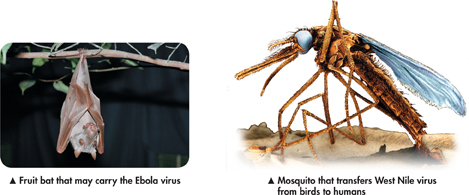Contaminated water may be consumed, or it may carry pathogens onto fruits or vegetables. If those foods are eaten without being washed thoroughly, infection can result. In recent years, several disease outbreaks have been traced to transmission through packaged salad greens.
Bacteria of several kinds are commonly present in seafood and uncooked meat, especially ground meat. If meats and seafood are not stored and cooked properly, illness can result.
Zoonoses: The Animal Connection Many diseases that have made headlines in recent years thrive in both human and other animal hosts. Any disease that can be transmitted from animals to humans is called a zoonosis (plural: zoonoses). Mad cow disease, severe acute respiratory syndrome (SARS), West Nile virus, Lyme disease, Ebola, and bird flu are all zoonoses. Transmission can occur in various ways. Sometimes an animal carries, or transfers, zoonotic diseases from an animal host to a human host. These carriers, called vectors, transport the pathogen but usually do not get sick themselves. In other cases, infection may occur when a person is bitten by an infected animal, consumes the meat of an infected animal, or comes in close contact with an infected animal's wastes or secretions.
MYSTERY CLUE

Many of the sick children remembered receiving strange insect bites that summer, which developed into rashes. What clue did this give Steere?

FIGURE 35–3 Vectors Vectors are animals that harbor a pathogen. The pathogen may spread to a human through the bite of the vector, or when a person eats the vector.
35.1 Assessment

-
Review List the types of organisms that can cause disease.
Explain What are ways that pathogens can cause disease in their hosts?
Infer If a researcher introduced a suspected pathogen into many healthy hosts, but none of them became sick, what could this indicate?
-
Review What are the ways in which infectious diseases are spread?
Explain How do vectors contribute to the spread of disease?
Apply Concepts Why do you think it's a beneficial adaptation for a pathogen to make its host very sick without killing the host? (Hint: Think about how viruses replicate.)
WRITE ABOUT SCIENCE
Animals infected with the virus that causes rabies often salivate excessively and are apt to bite other animals even when unprovoked. In a paragraph, explain how these symptoms lead to the spread of the virus.

Table of Contents
- Formulas and Equations
- Applying Formulas and Equations
- Mean, Median, and Mode
- Estimation
- Using Measurements in Calculations
- Effects of Measurement Errors
- Accuracy
- Precision
- Comparing Accuracy and Precision
- Significant Figures
- Calculating With Significant Figures
- Scientific Notation
- Calculating With Scientific Notation
- Dimensional Analysis
- Applying Dimensional Analysis




